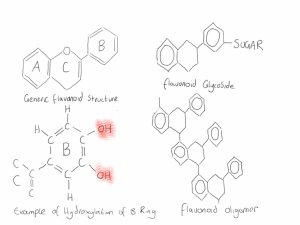Flavonoids are polyphenolic secondary plant metabolites. These molecules are often responsible for the red, blue and purple colours in fruits and petals. Flavonoids are bioavailable in humans and may have important biochemical properties in animals. For example, flavonoids may be important antioxidants and also be able to regulate gene expression. Health effects of dietary flavonoid have been extensively researched, and flavonoids may provide protection from cancer and cardiovascular disease. Many flavonoids are present in edible plants and so form an important component of the human diet. Flavonoids are a diverse group with thousands of examples in plants. However, only a much smaller amount are present in edible plants commonly consumed by humans. The prospect that many important dietary flavonoids have not yet been identified is highly likely. Fruits, vegetables, tea, wine, herbs, grains, seeds and chocolate are all important sources of flavonoids.
The flavonoid structure is based on a C6-C3-C6 diphenylpropane skeleton. Flavonoids are subdivided into the categories flavones, flavanones, flavan-3-ols, anthocyanins, based on the oxidation levels of their central pyran ring. Within the subgroup, hydroxylation patterns on the A, B and C ring define different flavonoids. Further, sugars can be added to the basic flavonoid structure to create further diversity. Addition of a sugar molecule forms a flavonoid glucoside if the sugar is a glucose molecule, or a flavonoid glycoside if some other sugar is involved. Flavonoids without sugars are referred to as aglycones. Flavonoids can also bond together to form complex oligomers. For example, the flavan-3-ols can bond together to form high molecular weight proanthocyanidins, which are found in chocolate, grape seed and pine bark. Many plant secondary metabolite have similar structures to flavonoids and are often grouped together including the chalcones, isoflavones and aurones, but these are not true flavonoids.
RdB

